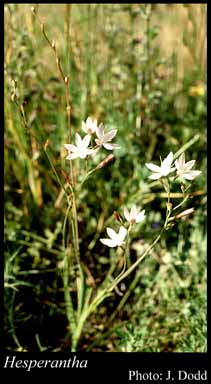- Reference
- Ann.Bot. 1:224 (1805)
- Name Status
- Current

Scientific Description
Family Iridaceae.
Habit and leaf form. Herbs (small); evergreen, or deciduous. Perennial (annual leaves and flowers). Leaves basal and cauline (mostly basal). Plants with a basal concentration of leaves, or with neither basal nor terminal concentrations of leaves; cormous (small, asymmetric, depressed-globular to campanulate; tunic of woody layers). Helophytic to xerophytic. Leaves alternate; distichous; ‘herbaceous’, or leathery; sessile; sheathing. Leaf sheaths with free margins. Leaves foetid, or without marked odour; edgewise to the stem, or with ‘normal’ orientation; simple; epulvinate. Leaf blades entire; flat; linear, or lanceolate; narrowly elliptic to linear, or ovate (or falcate); parallel-veined (several prominent veins); without cross-venules; open or closed sheath. Leaves eligulate; without stipules. Leaf blade margins entire. Leaves with a persistent basal meristem, and basipetal development. Leaf anatomy. Hairs absent. Extra-floral nectaries absent. Stem anatomy. Secondary thickening absent.
Reproductive type, pollination. Fertile flowers hermaphrodite. Unisexual flowers absent. Plants hermaphrodite. Floral nectaries present, or absent. Nectar secretion from the gynoecium (septal nectaries). Entomophilous, or ornithophilous, or anemophilous.
Inflorescence and flower features. Flowers solitary (sometimes), or aggregated in ‘inflorescences’; in spikes. The terminal inflorescence unit cymose, or racemose. Inflorescences terminal; scape erect, wiry, simple or few-branched; inflorescence cymose, lax, with green bracts, distichous, 3–10 flowered; spatheate (2, short, membranous, at least partially green). Flowers sessile; bracteate (2 enclose each flower, spathe-like, inserted at the base of the ovary, persistent, usually herbaceous or membranous at the apex; the inner bract often smaller and the apex shortly divided); ebracteolate; small to large; regular (usually), or very irregular (rarely); when irregular, zygomorphic; 3 merous; cyclic; tetracyclic. Perigone tube present. Perianth of ‘tepals’; 6; 2 -whorled; isomerous; petaloid; without spots, or spotted; similar in the two whorls, or different in the two whorls; white, or cream, or red (reddish, outside of the outer whorl). Androecial members definite in number. Androecium 3. Androecial members adnate; all equal; free of one another; 1 -whorled (representing the outer whorl). Androecium exclusively of fertile stamens. Stamens 3; all more or less similar in shape; reduced in number relative to the adjacent perianth to isomerous with the perianth; on the perianth tube, usually at the throat, opposite the outer segments; alterniperianthial (opposite the outer perianth lobes). Anthers basifixed; dehiscing via longitudinal slits; extrorse. Gynoecium 3 carpelled. The pistil 3 celled. Gynoecium partly petaloid, or non-petaloid; syncarpous; synstylovarious; inferior. Ovary plurilocular; 3 locular. The ‘odd’ carpel anterior. Gynoecium stylate. Styles 1; apical. Stigmas 3. Placentation axile. Ovules 20–50 per locule (many); arillate, or non-arillate; anatropous.
Fruit and seed features. Fruit thin-walled; dehiscent; a capsule. Capsules loculicidal (from the apex). Fruit 3 celled; 20–100 seeded (many). Seeds endospermic. Endosperm oily. Cotyledons 1 (coleoptile-like). Embryo straight (small). Testa without phytomelan.
Etymology. From the Greek for "evening" and "flower", as the flowers open in the late afternoon or evening.